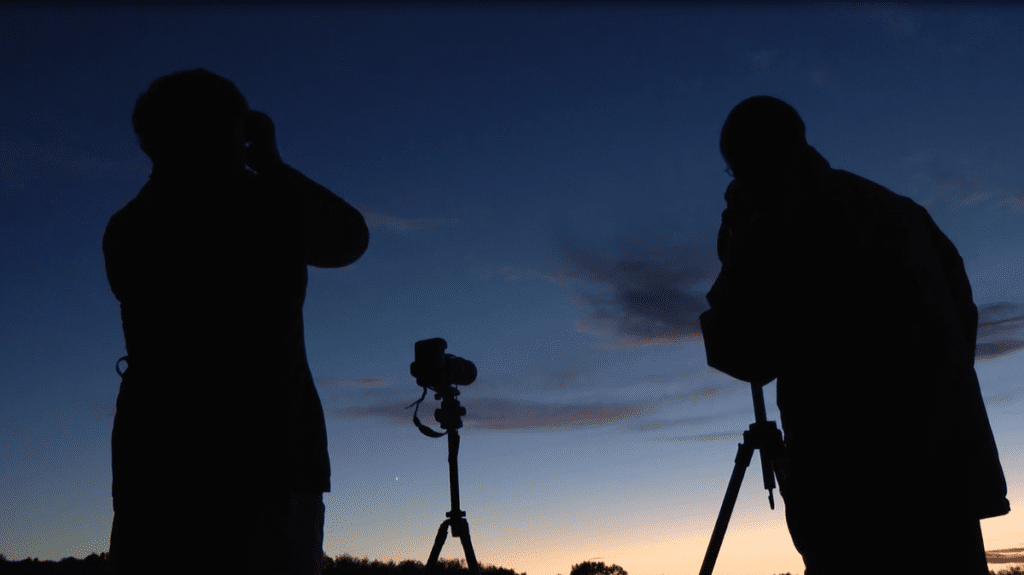At a farm in Concord, Massachusetts, astronomers, sky watchers and others gathered in the dark on Tuesday night, hoping to spot something never seen before.”Comet Tsuchinshan-ATLAS is going to appear when it gets dark, provided we have a clear sky tonight,” Dr. Daniel Green, a researcher at Harvard Planetary Sciences said.The group waited for about an hour after sunset, watching through high-powered cameras and binocularsIt was at that moment they saw something spectacular. The comet’s long tail, stretching millions of miles, making it visible in the night sky.”It’s only a small icy body only a few miles across, and yet it produces this huge amount of gas,” said Edwin, who came to watch the comet.One husband and wife have spent their lives chronicling the wonders in the sky and tonight was their best chance to see this comet.According to astronomers the best way to view a comet is to get away from city lights and use your peripheral vision, or averted view.”These are leftovers from the formation of our solar system and the fact you’re seeing it with your naked eye, makes it special,” Edwin said. “Once you see it, you’re gonna know.”Viewers from across Massachusetts and around the world reported spotting the comet Tuesday night.”I t came from the outer most reaches of the solar system where it was just barely still held by the suns gravity,” Dr. Green said.”It’s about half an astronomical unit, which is about 50-60 million miles away from the earth. That’s about the closest it’s coming to the earth.”Experts said the comet is pulling away from the sun now and will eventually fade away from view forever.”There have been rumors in the press I’m not sure where it started, that it comes around every 80-thousand years,” Dr. Green said.”Those are completely false. Its probably the first time its every been in the inner solar system and its never coming back. That’s such a bummer. Well there are so many more comets though.” The comet, also known as the A3 comet, can be best seen for the rest of the week. After that it’ll be gone for good.However, other comets will come around approximately every five to ten years.
At a farm in Concord, Massachusetts, astronomers, sky watchers and others gathered in the dark on Tuesday night, hoping to spot something never seen before.
“Comet Tsuchinshan-ATLAS is going to appear when it gets dark, provided we have a clear sky tonight,” Dr. Daniel Green, a researcher at Harvard Planetary Sciences said.
The group waited for about an hour after sunset, watching through high-powered cameras and binoculars
It was at that moment they saw something spectacular. The comet’s long tail, stretching millions of miles, making it visible in the night sky.
“It’s only a small icy body only a few miles across, and yet it produces this huge amount of gas,” said Edwin, who came to watch the comet.
One husband and wife have spent their lives chronicling the wonders in the sky and tonight was their best chance to see this comet.
According to astronomers the best way to view a comet is to get away from city lights and use your peripheral vision, or averted view.
“These are leftovers from the formation of our solar system and the fact you’re seeing it with your naked eye, makes it special,” Edwin said. “Once you see it, you’re gonna know.”
Viewers from across Massachusetts and around the world reported spotting the comet Tuesday night.
“I t came from the outer most reaches of the solar system where it was just barely still held by the suns gravity,” Dr. Green said.
“It’s about half an astronomical unit, which is about 50-60 million miles away from the earth. That’s about the closest it’s coming to the earth.”
Experts said the comet is pulling away from the sun now and will eventually fade away from view forever.
“There have been rumors in the press [and] I’m not sure where it started, that it comes around every 80-thousand years,” Dr. Green said.
“Those are completely false. Its probably the first time its every been in the inner solar system and its never coming back. That’s such a bummer. Well there are so many more comets though.”
The comet, also known as the A3 comet, can be best seen for the rest of the week. After that it’ll be gone for good.
However, other comets will come around approximately every five to ten years.

